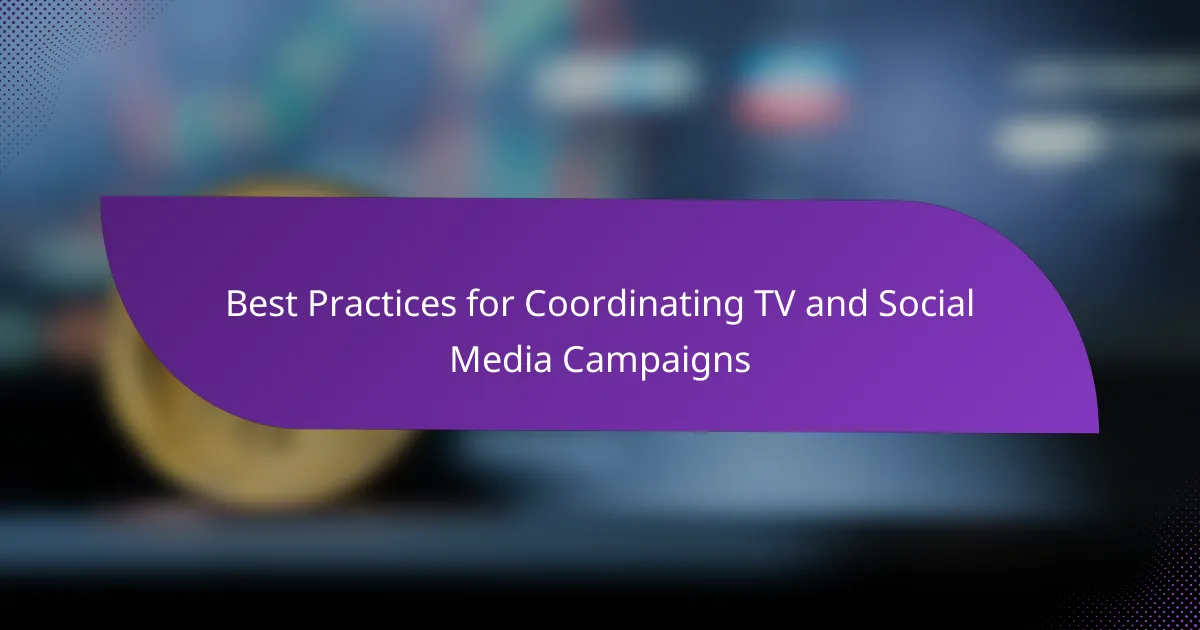Coordinating TV and social media campaigns requires a strategic approach that harmonizes messaging and content across both platforms to enhance audience engagement. By leveraging specialized tools and software, marketers can streamline processes and foster collaboration, ensuring a unified strategy. Additionally, measuring the effectiveness of these campaigns through key metrics allows for informed adjustments and maximizes return on investment.
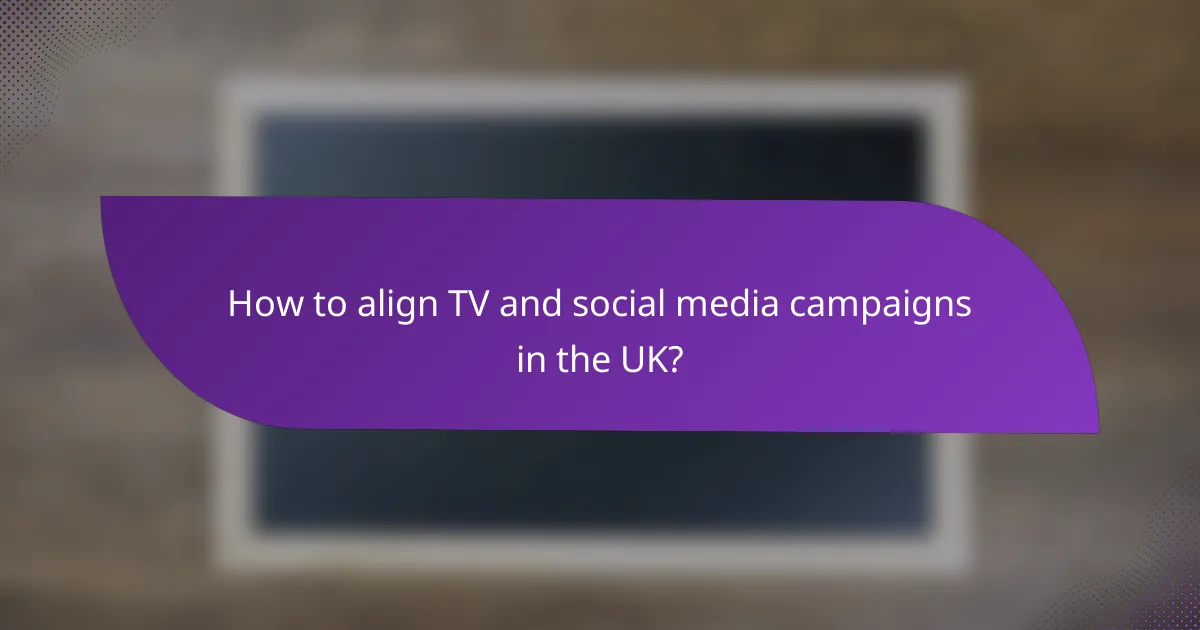
How to align TV and social media campaigns in the UK?
Aligning TV and social media campaigns in the UK involves creating a cohesive strategy that leverages both platforms to maximize audience engagement. This requires a clear understanding of messaging, content planning, and scheduling to ensure that both channels work in harmony.
Unified messaging strategy
A unified messaging strategy ensures that the core message of your campaign is consistent across TV and social media. This means using similar language, visuals, and themes to reinforce brand identity and campaign goals.
To achieve this, develop a messaging framework that outlines key messages, tone, and visual elements. Regularly review both platforms to ensure alignment and make adjustments as needed to maintain consistency.
Cross-channel content planning
Cross-channel content planning involves creating content that is tailored for both TV and social media while maintaining a cohesive narrative. Consider how each platform can complement the other; for instance, use social media to tease TV content or provide behind-the-scenes insights.
Plan your content calendar to synchronize posts and broadcasts, allowing for a seamless user experience. This can include scheduling social media posts to coincide with TV airings or creating shareable content that encourages audience interaction.
Integrated scheduling tools
Integrated scheduling tools help streamline the coordination of TV and social media campaigns. These tools allow you to manage and schedule content across multiple platforms from a single interface, reducing the risk of miscommunication.
Look for tools that offer analytics features to track performance across channels, enabling you to adjust your strategy based on real-time data. Popular options include Hootsuite, Sprout Social, and Buffer, which can help ensure that your campaigns are timely and effective.
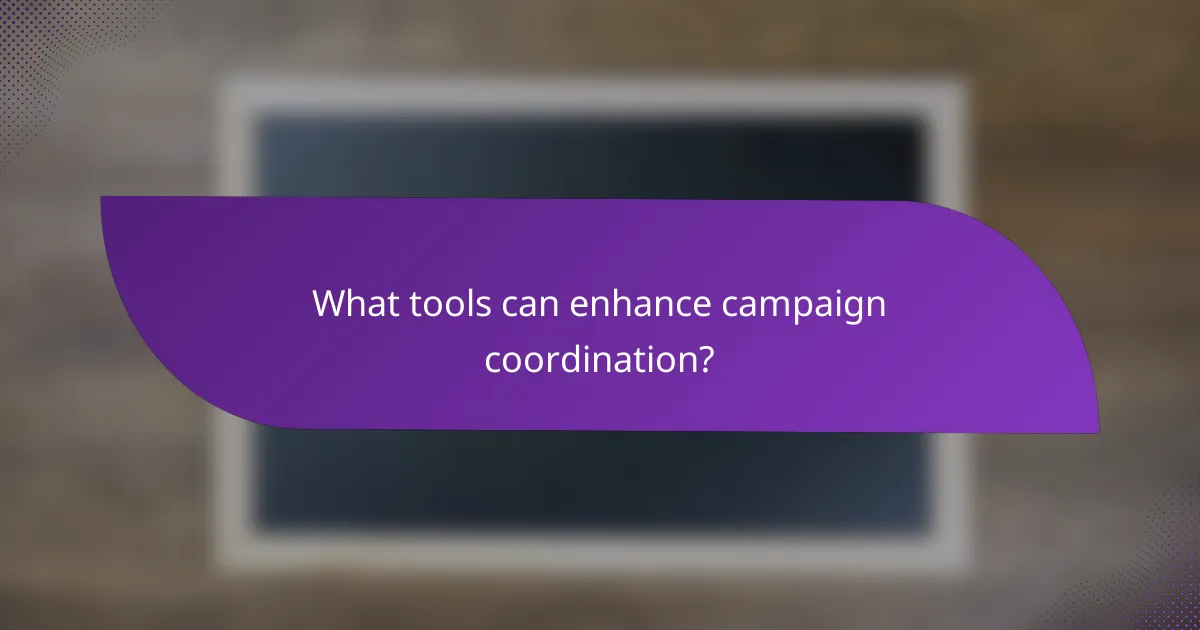
What tools can enhance campaign coordination?
Effective campaign coordination can be significantly improved with the right tools, which help streamline processes and provide valuable insights across platforms. Utilizing specialized software can enhance collaboration between TV and social media efforts, ensuring a cohesive strategy.
Hootsuite for social media management
Hootsuite is a powerful tool for managing multiple social media accounts from a single dashboard. It allows marketers to schedule posts, monitor engagement, and analyze performance metrics across various platforms like Facebook, Twitter, and Instagram.
To maximize its effectiveness, consider using Hootsuite’s analytics features to track the performance of posts related to your TV campaigns. This can help you identify which social media content resonates most with your audience, allowing for adjustments in real-time.
Sprinklr for cross-channel insights
Sprinklr offers comprehensive cross-channel marketing solutions that provide insights into customer interactions across social media and TV. This tool helps brands understand how their campaigns are performing collectively, rather than in isolation.
By leveraging Sprinklr’s reporting capabilities, you can analyze how TV ads drive social media engagement and vice versa. This insight allows for more informed decision-making and can enhance future campaign strategies.
TVSquared for TV analytics
TVSquared specializes in measuring the effectiveness of TV advertising by providing detailed analytics on viewer engagement and conversion rates. This tool enables marketers to see how TV spots influence online behavior and social media activity.
Using TVSquared, brands can assess the return on investment (ROI) of their TV campaigns and adjust their social media strategies accordingly. For instance, if a particular ad drives significant traffic to a website, you can amplify that message on social media to capitalize on the momentum.
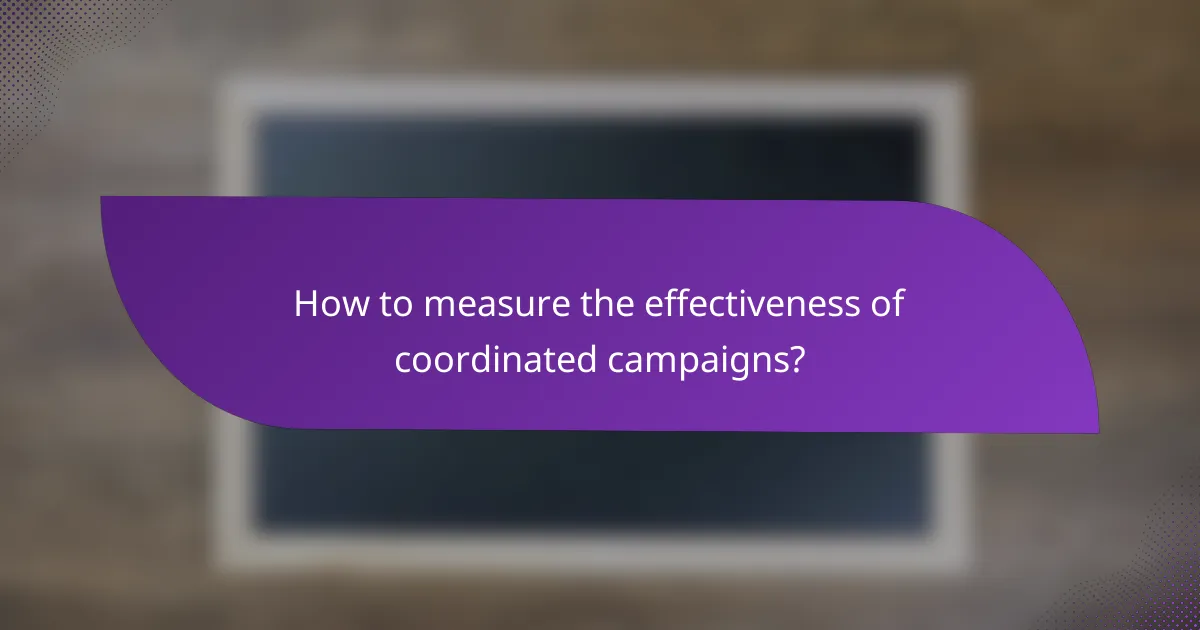
How to measure the effectiveness of coordinated campaigns?
Measuring the effectiveness of coordinated campaigns involves evaluating various metrics that reflect engagement, return on investment (ROI), and audience reach. By analyzing these factors, marketers can determine the success of their combined TV and social media efforts.
Engagement metrics across platforms
Engagement metrics are crucial for assessing how well your audience interacts with your content on both TV and social media. Key metrics include likes, shares, comments, and viewership ratings. For example, a campaign that generates high social media interactions alongside strong TV ratings indicates effective coordination.
Consider using tools that aggregate data from both platforms to get a comprehensive view of engagement. Tracking these metrics over time can help identify trends and inform future campaign strategies.
Attribution models for ROI analysis
Attribution models help determine how much credit each channel deserves for conversions resulting from coordinated campaigns. Common models include first-touch, last-touch, and multi-touch attribution, each offering different insights into customer journeys. For instance, a multi-touch model might show that both TV ads and social media posts contribute significantly to a sale.
When analyzing ROI, consider the costs associated with each channel and the revenue generated. This analysis can guide budget allocation for future campaigns, ensuring that resources are directed toward the most effective channels.
Audience reach comparisons
Comparing audience reach across TV and social media is essential for understanding the overall impact of your campaigns. TV typically reaches a broader audience, while social media allows for targeted engagement with specific demographics. For example, a campaign might reach millions on TV but engage thousands on social media, providing a different type of interaction.
Utilize analytics tools to measure reach on both platforms. This data can help refine targeting strategies, ensuring that future campaigns effectively reach the desired audience segments while maximizing overall exposure.
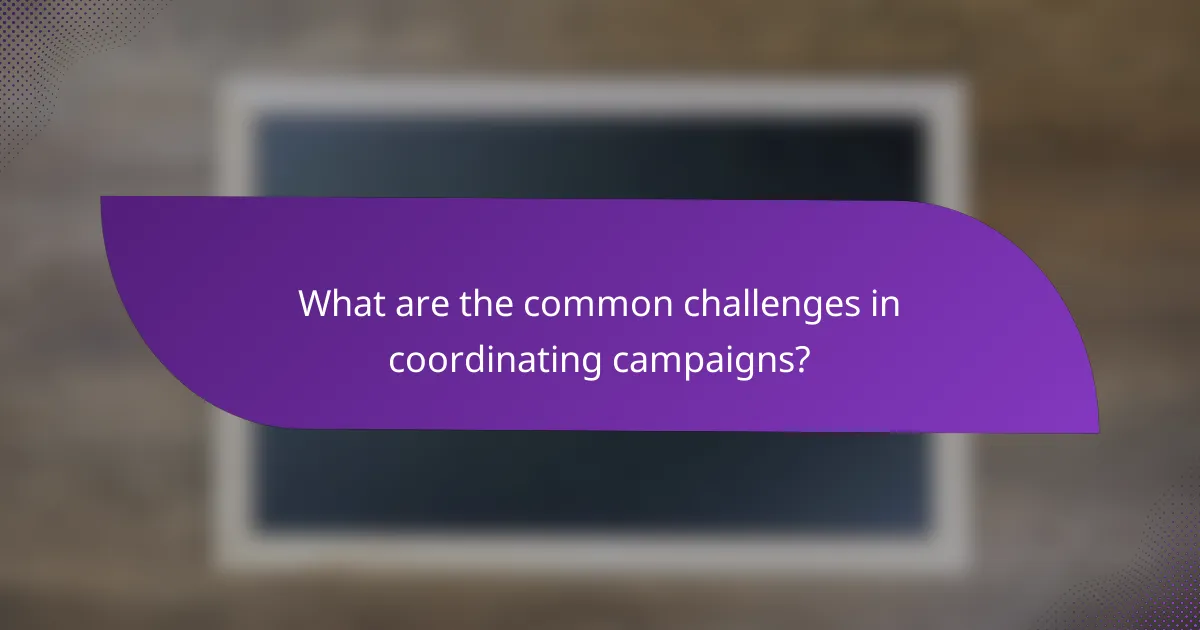
What are the common challenges in coordinating campaigns?
Coordinating TV and social media campaigns often presents challenges such as content inconsistency, timing discrepancies, and data silos between teams. Addressing these issues is crucial for creating a unified brand message and maximizing audience engagement.
Content inconsistency
Content inconsistency arises when messaging differs across TV and social media platforms, leading to confusion among audiences. To maintain coherence, ensure that all teams are aligned on the campaign’s core message and visual identity.
Establish a style guide that outlines tone, language, and branding elements to be used across all platforms. Regular check-ins between teams can help identify and rectify discrepancies before they reach the audience.
Timing discrepancies
Timing discrepancies occur when TV ads and social media posts are not synchronized, which can dilute the campaign’s impact. It’s essential to create a detailed timeline that outlines when each component of the campaign will be launched.
Utilize scheduling tools to coordinate the release of content across platforms. Consider the viewing habits of your target audience to optimize the timing of both TV and social media posts for maximum engagement.
Data silos between teams
Data silos between teams can hinder the ability to analyze campaign performance effectively. When social media and TV teams operate independently, valuable insights may be lost, preventing informed decision-making.
Encourage collaboration by sharing analytics and performance metrics across teams. Implementing a centralized dashboard can facilitate access to data, allowing for real-time adjustments to the campaign based on performance insights.

How to create a successful campaign workflow?
A successful campaign workflow integrates TV and social media efforts to maximize reach and engagement. This involves clear planning, defined roles, and effective communication among team members to ensure all aspects of the campaign align and function smoothly.
Define roles and responsibilities
Clearly defining roles and responsibilities is crucial for a successful campaign workflow. Each team member should understand their specific tasks, whether it’s content creation, scheduling, or analytics. This clarity helps prevent overlaps and gaps in the campaign execution.
For example, assign one person to oversee social media posts while another manages TV ad placements. This division allows for focused expertise and accountability, enhancing overall campaign effectiveness.
Establish communication protocols
Effective communication protocols ensure all team members are informed and aligned throughout the campaign. Regular check-ins, updates, and feedback loops can help maintain momentum and address any issues promptly.
Consider using tools like Slack or Microsoft Teams for real-time communication, and schedule weekly meetings to review progress and adjust strategies as needed. This structured approach fosters collaboration and keeps everyone on the same page.
Utilize project management software
Project management software can streamline the workflow by providing a centralized platform for tracking tasks, deadlines, and progress. Tools like Trello, Asana, or Monday.com help visualize the campaign timeline and responsibilities.
Using these tools, teams can assign tasks, set due dates, and monitor completion status, which enhances accountability and efficiency. Ensure everyone is trained on the chosen software to maximize its benefits and avoid confusion.

What are the best practices for content creation?
Effective content creation for TV and social media campaigns requires a strategic approach that aligns messaging across platforms while catering to their unique audiences. Prioritizing tailored content, user engagement, and real-time interaction can significantly enhance campaign effectiveness.
Tailor content for each platform
Adapting content for each platform is crucial for maximizing engagement. For instance, a 30-second TV spot can be complemented by shorter, punchy clips for social media, ensuring that the message resonates with users who prefer quick consumption. Consider the audience’s behavior on each platform; Instagram favors visuals, while Twitter thrives on concise text updates.
Utilize platform-specific features, such as Instagram Stories or Facebook Live, to create immersive experiences. This approach not only enhances user interaction but also reinforces brand messaging across different channels.
Leverage user-generated content
User-generated content (UGC) can significantly boost authenticity and trust in your campaign. Encourage your audience to share their experiences related to your brand, which can then be featured in your social media posts or even integrated into TV ads. This strategy not only fosters community but also provides fresh content that resonates with potential customers.
Consider running contests or campaigns that incentivize users to create and share content. This can lead to a wealth of material that showcases real-life applications of your product or service, enhancing relatability and engagement.
Incorporate real-time feedback
Real-time feedback allows brands to adjust their campaigns dynamically based on audience reactions. Monitor social media interactions closely during and after TV broadcasts to gauge viewer sentiment and engagement levels. This data can inform immediate content adjustments or future campaign strategies.
Utilize tools that track mentions and engagement metrics to identify trends and areas for improvement. Responding to audience feedback promptly can enhance brand loyalty and demonstrate that you value customer input, making your campaigns more effective over time.
